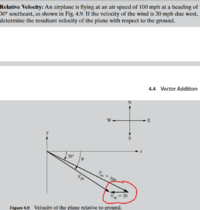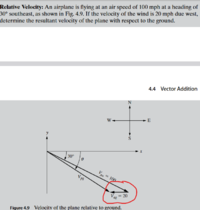coooool222
Junior Member
- Joined
- Jun 1, 2020
- Messages
- 93
Is angle Vag 180 since the vector is a straight line pointing left?
Also you can add 30 degrees with 150 which will be 180?
Relative Velocity: An airplane is flying at an air speed of 100 mph at a heading of 30 degrees southeast. If the velocity of the wind is 20 mph due west, determine the resultant velocity of the plane with respect to the ground.

Also you can add 30 degrees with 150 which will be 180?
Relative Velocity: An airplane is flying at an air speed of 100 mph at a heading of 30 degrees southeast. If the velocity of the wind is 20 mph due west, determine the resultant velocity of the plane with respect to the ground.

Last edited by a moderator:

